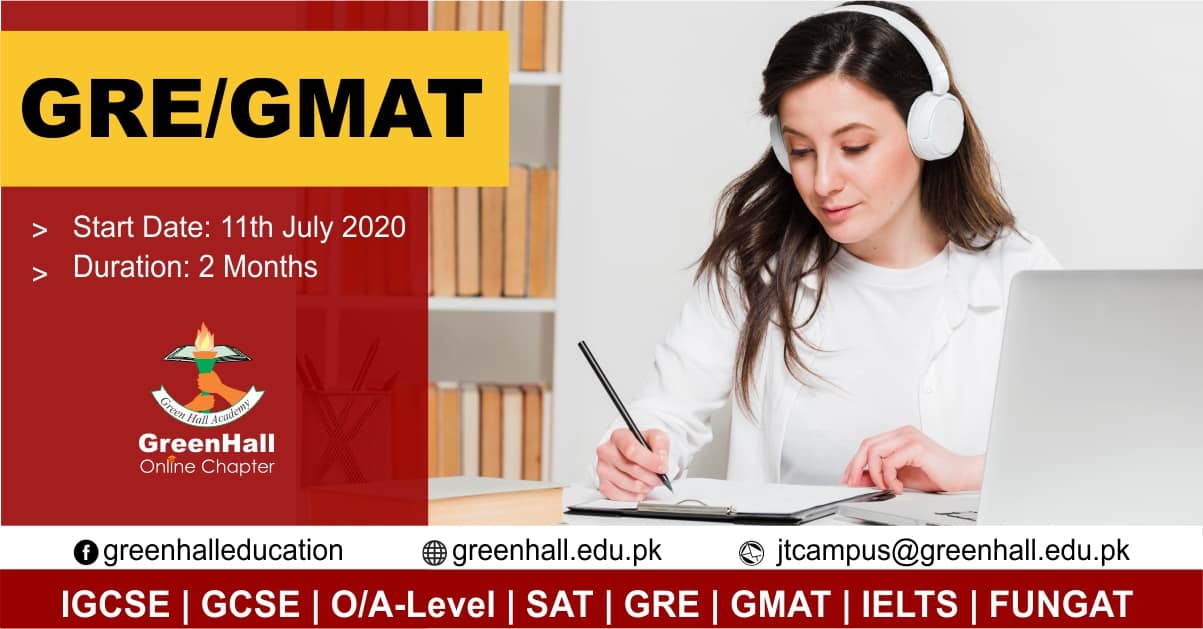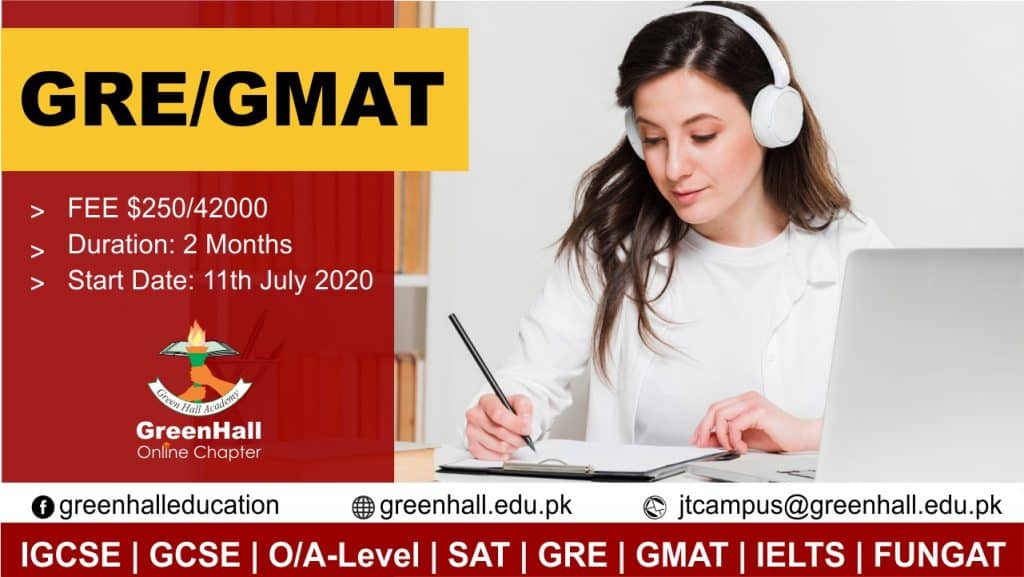Blog
IGCSE, SAT I & II, GRE / GMAT New Online Sessions !!!
IGCSE, SAT I & II, GRE / GMAT New Online Sessions !!!
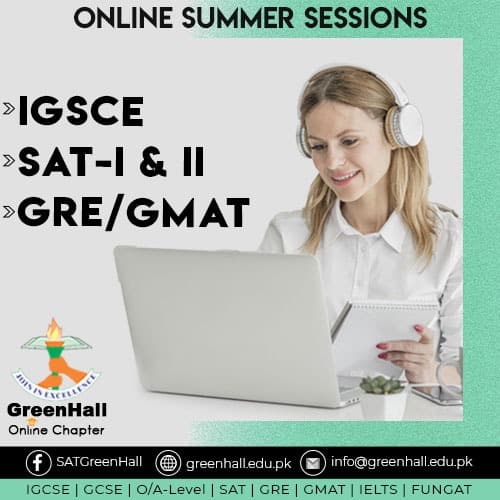
GRE/GMAT New Online Session will start from 11th July 2020 !!!
With ‘management’ forming part of its acronym, you might expect the GMAT to hold some sway over its GRE counterpart, if MBA admissions and related business master’s programs are the main goal. The test does place a heavier focus on quantitative and analytical skills – interpreting data presented in text, charts and tables to solve complex problems, for example. Tasks are therefore customized to evaluate skills seen as being specific to business managers.
The GRE, as a more versatile test, has less of a focus of math and includes a calculator for its quantitative problems. However, for those for whom English is not their first language, the verbal section may be more challenging than the GMAT’s, as it places an emphasis on vocabulary rather than on grammar.
The GMAT is a computer-adaptive test – this means that the questions you answer correctly, or incorrectly, determine the difficulty level of the questions that follow. During the GMAT, students can’t go back and review their previous answers. The GRE, meanwhile, is not a computer-adaptive test and allows students to check their previous answers.
For Details:
WhatsApp: https://wa.me/923125314147
https://forms.gle/oubyDPEYYGzBSjn36
[email protected]
www.greenhall.edu.pk
Call +923125314147
or
Visit any of our nearest campus.
Wapda Town: +923116333444
Faisal Town: +923116333777
Gulberg Campus:+92312-5314148
Johar Town: +923116333666
Paragon : +923207777456
DHA Phase I: +92331-5314143
DHA Phase IV: +92320-6666989.
GRE/GMAT New Online Session will start from 11th July 2020 !!!
With ‘management’ forming part of its acronym, you might expect the GMAT to hold some sway over its GRE counterpart, if MBA admissions and related business master’s programs are the main goal. The test does place a heavier focus on quantitative and analytical skills – interpreting data presented in text, charts and tables to solve complex problems, for example. Tasks are therefore customized to evaluate skills seen as being specific to business managers.
The GRE, as a more versatile test, has less of a focus of math and includes a calculator for its quantitative problems. However, for those for whom English is not their first language, the verbal section may be more challenging than the GMAT’s, as it places an emphasis on vocabulary rather than on grammar.
The GMAT is a computer-adaptive test – this means that the questions you answer correctly, or incorrectly, determine the difficulty level of the questions that follow. During the GMAT, students can’t go back and review their previous answers. The GRE, meanwhile, is not a computer-adaptive test and allows students to check their previous answers.
For Details:
WhatsApp: https://wa.me/923125314147
https://forms.gle/oubyDPEYYGzBSjn36
[email protected]
www.greenhall.edu.pk
Call +923125314147
or
Visit any of our nearest campus.
Wapda Town: +923116333444
Faisal Town: +923116333777
Gulberg Campus:+92312-5314148
Johar Town: +923116333666
Paragon : +923207777456
DHA Phase I: +92331-5314143
DHA Phase IV: +92320-6666989.
SAT I & II New Session will Start from 06th July 2020 !!! Best SAT Online Academy Lahore
SAT I & II New Session will Start from 06th July 2020 !!! Best SAT Online Academy Lahore
SAT I is a prerequisite for all undergraduate
programs offered at most of Top universities in USA and in Pakistan like LUMS.
Achieve High Score in SAT through Green Hall Academy and apply in
LUMS & in Top Universities of world !
Registrations Open for New Session.
GreenHall Academy also caters to students who wish to secure a place in renowned national and international universities on the basis of the SAT. The duration for the SAT-I is of two months and the course is designed for students aspiring to join the academic disciplines of Business, Humanities or Miscellaneous courses, while the SAT-II syllabus is specifically for students who require the test for admission in either a Medical or Engineering discipline. Our faculty for SAT-I & II comprise of some of the most renowned teachers who master in preparing students for the SAT’s. These teachers through their vast experience and keeping in view the current standards of the College Board have devised a course pattern which guarantees a maximum score in the SAT’s.
SAT is a paper-based standardized test that is used as one of the entrance criteria for admission to universities and colleges in the US & Pakistan ( LUMS , IBA , NUST etc) . School students from around the world take the SAT to showcase their college-preparedness and skills that they have developed at school.
SAT has the following test format:
| SECTION | QUESTIONS | TIME IN MINUTES |
| Reading | 52 | 65 |
| Writing and Language | 44 | 35 |
| Math | 58 | 80 |
| SAT Essay | 1 task | 50 |
SAT Test Format
The SAT exam lasts for 3 hours and 50 minutes if you choose to write the essay. The score ranges from 400-1600. Take a look at the latest SAT syllabus 2018-19 and make sure that you are headed in the right direction with your SAT prep.
-
Reading
This section is a part of the Evidence-Based Reading and Writing component of the SAT. It consists of 4-5 passages and a total of 52 questions. You are required to read and understand these passages and answer the questions that follow within 65 minutes.
Each 500-750 words-long passage may be taken from:
- Classic or contemporary work of US or world literature
- Document or speech related to the Constitution and founding of the US
- A selection about economics, psychology, sociology, etc.
Each passage is followed by 10-12 multiple-choice questions with four answer choices. Broadly speaking, the questions are of the following types:
- Main idea or central theme of the passage
- Explanation or inference of a phrase used in the passage
- Function of a phrase or sentence in the passage
- Style, tone, perspective or attitude of the author
- Evidence that supports a stance
- Data analysis on the basis of diagrams, charts or graphs
SAT does not expect you to have prior knowledge of the passage topics as the questions that are asked are always based on the passage. However, familiarity with these topics is recommended because one, it helps you develop a reading habit and two, it is a definitive confidence-building measure.
-
Writing and Language
This section is a part of the Evidence-Based Reading and Writing component of the SAT. It consists of 4 passages and a total of 44 multiple-choice questions. You are required to read and understand these passages and answer the questions that follow in 35 minutes.
Each passage may be taken from articles or write-ups related to:
- Careers
- Science
- History or Social Studies
- Humanities
Commonly-asked question types are based on:
- Strengthen/weaken the argument
- Word choice regarding text, style or tone
- Structural changes to ensure correctness or improve readability
- Sentence structure, punctuation, grammar usage involving verb tense, parallel construction, subject-verb agreement, etc.
Prior knowledge of topics is not required as all questions lie within the scope of the passage. Some passages may be accompanied by graphs or charts that check your interpretative skills (not mathematical skills).
Together, the above two sections are scored on a scale of 200-800.
-
Math
The Math component of the SAT has two parts: Math Test-Calculator and Math Test-No calculator. Math Test-Calculator has 38 questions to be answered within 55 minutes and Math Test-No Calculator has 20 questions to be answered within 25 minutes. The calculator part of the test involves complex calculations that necessitates the use of calculator, but if you are comfortable you can choose not to use one. Check out SAT-approved calculators.
The Math test focuses on three core areas:
-
Heart of Algebra
Linear equations with rational coefficients, system of linear equations(with no solution, finite or infinite solutions), linear inequalities in two variables and their systems, graphical representation of linear function.
-
Problem-solving and Data Analysis
Percentages; ratio and proportion; unit conversion; equation of line or curve using a scatterplot; two-way tables to calculate conditional frequencies and conditional probabilities; association of variables or independence of events; estimation of a population parameter; calculation of mean, median, mode, range and standard deviation in statistics; evaluation of reports to check appropriateness of data collection methods.
-
Passport to Advanced Math
Quadratic equations with rational coefficients; determination of the most suitable form of an expression; addition, subtraction, multiplication and division of polynomial equations; zeros and factors of polynomials, non-linear relationship between two variables, function notation, isolation of a variable by rearrangement of formula or equation.
SAT provides you with a cheat sheet of important formulae. Although most questions in the Math section are multiple-choice, 22 per cent are grid-in questions wherein a student has to solve the problem, write the correct answer in the box provided and circle the corresponding bubble in the OMR sheet provided.
The Math section is scored on a scale of 200-800.
-
-
SAT Essay
This is the optional component of the SAT. However, some universities require or recommend it. Check SAT essay requirements in your college of choice.
SAT essay allows you to demonstrate your reading, analysis and writing skills. You are given 50 minutes to read a 650-750 words-long passage and then write an analysis about how the author builds his or her argument. This type of question is a standard feature of the SAT essay. The passage, of course, varies each time. Remember, you are required to analyse the author’s text and identify the evidence that the author uses to support his or her argument. So, refrain from stating your opinion. Take a look at the SAT Essay Guide to know more.
Whether you have just begun your SAT prep or are nearly done with it, it always helps to streamline your prep with the latest SAT syllabus with GreenHall Academy. Happy prepping!
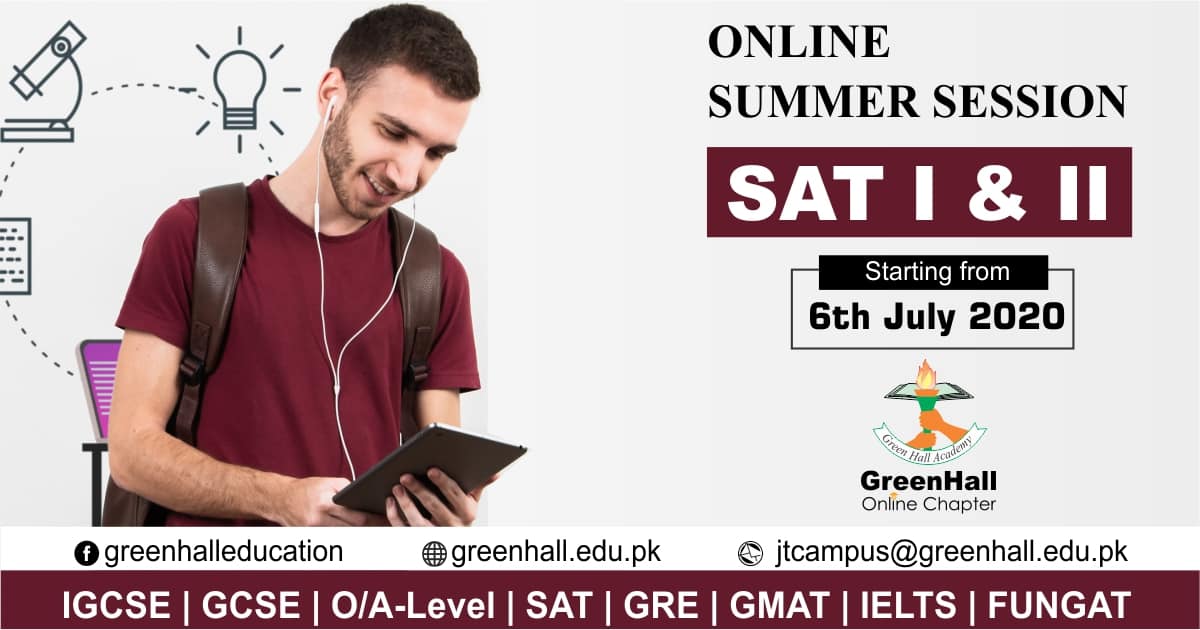
GreenHall Academy .
IGCSE Academy Lahore New Online Session will start from 8th July 2020 !!!
What is IGCSE?
IGCSE is the abbreviation of International General Certificate of Secondary Education. It is world most popular international certification for end of secondary school (equivalent to O-Level, UK GCSE, fifth form or year 11 in respective countries and schools), before one proceeds to Advanced Level (A-Level or sixth form or year 12&13) or pre-university studies.
IGCSE was developed by Cambridge International Examinations (previously known as University of Cambridge International Examinations), in short CIE, in 1988. University of Cambridge has been the UK local examination board since 1858. The term “IGCSE” is a registered trademark of University of Cambridge. Generally, when one mentions IGCSE, it is understood as the Cambridge IGCSE from the CIE board.
The IGCSE curriculam is often considered more similar to O-Level rather than the UK national curriculums GCSE. Thus, the basis of the examination is also considered more challenging and rigorous.
Recognition
Many universities worldwide require a combination of Cambridge International A Levels and Cambridge IGCSEs to meet their entry requirements. For example, leading US and Canadian universities require Cambridge International AS & A Levels, but some US and Canadian colleges and universities will accept learners with five Cambridge IGCSEs at grade C or above.
In the UK, Cambridge IGCSE is accepted as equivalent to the GCSE. Many UK universities look at Cambridge IGCSE grades, as well as predicted grades for Cambridge International A Level, when making admissions decisions.
IGCSE is also popular among homeschoolers, and adult students. Though IGCSE is being taken by students typically in the age group 14-16 (or 15-17 depending on primary 1 entry age), it also allows students from alternative education and adult students to sit for the exam and continue personal education advancement at any age.
Some homeschooling educators in the US are choosing IGCSE as oppose to the standard American high school curriculums, because it is said to be a year (or more) advanced than the standard American high school course.
Subjects
IGCSE offers more than 70 subjects. Students are required to take a minimum of 5 or maximum of 14 subjects. The core subjects are English, Mathematics and Sciences. Students can also choose other subjects ranging from Social Sciences (commonly Accounting, Business Studies, Economics, Sociology) to Arts & Technology (commonly Computer Studies, Information & Communication Technology (ICT), Art & Design).
Student is awarded with one IGCSE certificate on each subject. If you take 5 subjects, you will be awarded 5 IGCSE certificates. The number of subjects need to be taken is varied from school to school, and also depends upon individual preference.
Cambridge IGCSE subjects
Regularly updated and extended, Cambridge IGCSE provides you with a wide range of well-resourced and supported courses.
GreenHall Academy Currently offering following subjects.
Math , Physics , Chemistry , Biology , ICT , English.
The IGCSE is graded from A* to G, with U stated as “Ungraded”. Students are required to obtain minimum grade C for the 5 core subjects in order to proceed to the next advanced level or further education. IGCSE grading overview is as below:
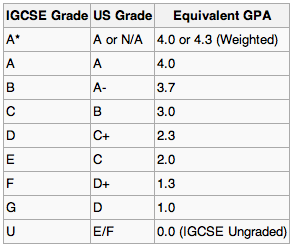
Difference between IGCSE Core and IGCSE Extended
To take account of differing abilities, there is a choice between Core and Extended curriculum papers in most subjects. This allows teachers to decide on the most appropriate level of papers for their students.
The Core curriculum in each subject is within the ability range of a large majority of students. It provides a full overview of the subject and is targeted at students expected to achieve grades C to G.
The Extended curriculum, which comprises the Core curriculum and the Supplement, has been designed for the more academically able and leads naturally into higher education or professional training. It is targeted at those expected to achieve grades A* to E. The Supplement describes the extra topics or depth which must be added to the Core to produce the Extended curriculum.
Students need not enter for the same level of curriculum in all subjects.
| Target Grades | Grades Available | |
| Core Curriculum | C D E F G | |
| Extended Curriculum | A* A B C D E |
The overlap of three grades (C, D and E) is designed to accommodate students who perform either better or worse than their teachers expect. Students who fail to meet the minimum satisfactory standard for either the Core curriculum (Grade G) or the Extended curriculum (Grade E) will be ungraded.
In a few subjects, the examination covers the complete ability range and there is no choice of curriculum. For these subjects, the full range of grades is available.
Group Award ? Cambridge ICE
The Cambridge ICE certificate is a group award designed for schools that want to offer a broad curriculum. Candidates enter and sit for a minimum of seven subjects selected from the five IGCSE curriculum areas:
-
- Group 1 – Languages
-
- Group 2 – Humanities and Social Sciences
-
- Group 3 – Sciences
-
- Group 4 – Mathematics
- Group 5 – Creative, Technical and Vocational
Cambridge ICE is awarded to candidates who pass in at least 7 (seven) Cambridge IGCSE subjects, including two from Group 1 and one from each of Groups 2 to 5. The seventh subject may be chosen from any of the syllabus groups.
Candidates who qualify for the Cambridge ICE award will be placed in one of three categories:
Distinction – Grade A or better in five subjects and grade C or better in two subjects.
Merit – Grade C or better in five subjects and grade F or better in two subjects.
Pass – Grade G or better in seven subjects.

GRE / GMAT New Online Session will start from 11th July 2020 !!!
The GREis accepted at 1200+ Business Schools worldwide. Its Unique Quantitative Question focuses on quantitative comparisons, while the GRE’s Unique Verbal Questions look at Sentence Equivalence & Text Completion. This test is better for creative/flexible thinkers.
The GMATis accepted by all business schools. Its Unique Quantitative Question focuses on Data Sufficiency, while the GMAT’s Unique Verbal Questions look at Sentence Correction & Critical Reasoning. This test is better for number-crunching thinkers.
Differences between the GMAT and GRE
With ‘management’ forming part of its acronym, you might expect the GMAT to hold some sway over its GRE counterpart, if MBA admissions and related business master’s programs are the main goal. The test does place a heavier focus on quantitative and analytical skills – interpreting data presented in text, charts and tables to solve complex problems, for example. Tasks are therefore customized to evaluate skills seen as being specific to business managers.
The GRE, as a more versatile test, has less of a focus of math and includes a calculator for its quantitative problems. However, for those for whom English is not their first language, the verbal section may be more challenging than the GMAT’s, as it places an emphasis on vocabulary rather than on grammar.
The GMAT is a computer-adaptive test – this means that the questions you answer correctly, or incorrectly, determine the difficulty level of the questions that follow. During the GMAT, students can’t go back and review their previous answers. The GRE, meanwhile, is not a computer-adaptive test and allows students to check their previous answers.
Here is a table that outlines the principal differences between the GMAT and GRE:
GMAT |
GRE |
|
| Content |
GMAT verbal places greater emphasis on grammar, logic and reasoning. GMAT quant is harder if math isn’t your strength. |
GRE places more focus on vocabulary, making it easier for native versus non-native English speakers.
If math isn’t your forte, the GRE could be more suited to you.
|
| Format | Computer-adaptive test | Computer delivered or paper delivered |
| Test time | 3 hours 30 minutes | 3 hours 45 minutes |
| How it’s scored | Total scores range from 200-800. The mean score among 750k test takers between 2013 and 2015 was 552, while a score of 700 would have put you in the 89th percentile | Scores from 130-170 in 1 point increments for verbal and quantitative reasoning sections; scores from 0-6 in analytical writing |
| Cost | US$250 | US$205 |
| Score validity | 5 years | 5 years |
| Source: GMAT and ETS (GRE) websites | ||
Top schools take a holistic approach to the MBA admissions process
Most business schools opt to accept GRE scores as an alternative to the GMAT so as to widen their pool of applicants, and bring in students from backgrounds outside of the ‘traditional’ norm – those with backgrounds in finance, accounting, economics and so on. Diversity, in all of its forms, matters and is therefore positively encouraged at top business schools.
‘Holistic’ is a word commonly used by institutions to describe their approach to reviewing MBA applications. The GMAT and the GRE are therefore just one element of the evaluation process – academic background, personality, experience, and the effort you invest in the application process are all just as important.
The key to choosing the GMAT or GRE for MBA admission is to first identify which of your chosen schools require which test. If you think a school might accept both, but could prefer one test over the other, email, phone, or chat online to find out.
Playing to your strengths is also a factor. If your dream school can confirm that it values both tests equally, simply choose the one you think you’ll do best in. Lastly, whether you’re taking the GMAT or GRE for MBA admission, make sure you go into the test fully prepared!
Visit any campus of GreenHall Academy for further details.
For Details:
WhatsApp: https://wa.me/923125314147
https://forms.gle/oubyDPEYYGzBSjn36
[email protected]
www.greenhall.edu.pk
Call +923125314147
or
Visit any of our nearest campus.
Wapda Town: +923116333444
Faisal Town: +923116333777
Gulberg Campus:+92312-5314148
Johar Town: +923116333666
Paragon : +923207777456
DHA Phase I: +92331-5314143
DHA Phase IV: +92320-6666989.
GRE / GMAT New Online Session will start from 11th July 2020 ! Achieve Best Score.
The GREis accepted at 1200+ Business Schools worldwide. Its Unique Quantitative Question focuses on quantitative comparisons, while the GRE’s Unique Verbal Questions look at Sentence Equivalence & Text Completion. This test is better for creative/flexible thinkers.
The GMATis accepted by all business schools. Its Unique Quantitative Question focuses on Data Sufficiency, while the GMAT’s Unique Verbal Questions look at Sentence Correction & Critical Reasoning. This test is better for number-crunching thinkers.
Differences between the GMAT and GRE
With ‘management’ forming part of its acronym, you might expect the GMAT to hold some sway over its GRE counterpart, if MBA admissions and related business master’s programs are the main goal. The test does place a heavier focus on quantitative and analytical skills – interpreting data presented in text, charts and tables to solve complex problems, for example. Tasks are therefore customized to evaluate skills seen as being specific to business managers.
The GRE, as a more versatile test, has less of a focus of math and includes a calculator for its quantitative problems. However, for those for whom English is not their first language, the verbal section may be more challenging than the GMAT’s, as it places an emphasis on vocabulary rather than on grammar.
The GMAT is a computer-adaptive test – this means that the questions you answer correctly, or incorrectly, determine the difficulty level of the questions that follow. During the GMAT, students can’t go back and review their previous answers. The GRE, meanwhile, is not a computer-adaptive test and allows students to check their previous answers.
Here is a table that outlines the principal differences between the GMAT and GRE:
GMAT |
GRE |
|
| Content |
GMAT verbal places greater emphasis on grammar, logic and reasoning. GMAT quant is harder if math isn’t your strength. |
GRE places more focus on vocabulary, making it easier for native versus non-native English speakers.
If math isn’t your forte, the GRE could be more suited to you.
|
| Format | Computer-adaptive test | Computer delivered or paper delivered |
| Test time | 3 hours 30 minutes | 3 hours 45 minutes |
| How it’s scored | Total scores range from 200-800. The mean score among 750k test takers between 2013 and 2015 was 552, while a score of 700 would have put you in the 89th percentile | Scores from 130-170 in 1 point increments for verbal and quantitative reasoning sections; scores from 0-6 in analytical writing |
| Cost | US$250 | US$205 |
| Score validity | 5 years | 5 years |
| Source: GMAT and ETS (GRE) websites | ||
Top schools take a holistic approach to the MBA admissions process
Most business schools opt to accept GRE scores as an alternative to the GMAT so as to widen their pool of applicants, and bring in students from backgrounds outside of the ‘traditional’ norm – those with backgrounds in finance, accounting, economics and so on. Diversity, in all of its forms, matters and is therefore positively encouraged at top business schools.
‘Holistic’ is a word commonly used by institutions to describe their approach to reviewing MBA applications. The GMAT and the GRE are therefore just one element of the evaluation process – academic background, personality, experience, and the effort you invest in the application process are all just as important.
The key to choosing the GMAT or GRE for MBA admission is to first identify which of your chosen schools require which test. If you think a school might accept both, but could prefer one test over the other, email, phone, or chat online to find out.
Playing to your strengths is also a factor. If your dream school can confirm that it values both tests equally, simply choose the one you think you’ll do best in. Lastly, whether you’re taking the GMAT or GRE for MBA admission, make sure you go into the test fully prepared!

Visit any campus of GreenHall Academy for further details.
For Details:
WhatsApp: https://wa.me/923125314147
https://forms.gle/oubyDPEYYGzBSjn36
[email protected]
www.greenhall.edu.pk
Call +923125314147
or
Visit any of our nearest campus.
Wapda Town: +923116333444
Faisal Town: +923116333777
Gulberg Campus:+92312-5314148
Johar Town: +923116333666
Paragon : +923207777456
DHA Phase I: +92331-5314143
DHA Phase IV: +92320-6666989.
SAT I & II New Session will Start from 06th July 2020 !!! Best SAT Online Academy Lahore
SAT I & II New Session will Start from 06th July 2020 !!! Best SAT Online Academy Lahore
SAT I is a prerequisite for all undergraduate
programs offered at most of Top universities in USA and in Pakistan like LUMS.
Achieve High Score in SAT through Green Hall Academy and apply in
LUMS & in Top Universities of world !
Registrations Open for New Session.
GreenHall Academy also caters to students who wish to secure a place in renowned national and international universities on the basis of the SAT. The duration for the SAT-I is of two months and the course is designed for students aspiring to join the academic disciplines of Business, Humanities or Miscellaneous courses, while the SAT-II syllabus is specifically for students who require the test for admission in either a Medical or Engineering discipline. Our faculty for SAT-I & II comprise of some of the most renowned teachers who master in preparing students for the SAT’s. These teachers through their vast experience and keeping in view the current standards of the College Board have devised a course pattern which guarantees a maximum score in the SAT’s.
SAT is a paper-based standardized test that is used as one of the entrance criteria for admission to universities and colleges in the US & Pakistan ( LUMS , IBA , NUST etc) . School students from around the world take the SAT to showcase their college-preparedness and skills that they have developed at school.
SAT has the following test format:
| SECTION | QUESTIONS | TIME IN MINUTES |
| Reading | 52 | 65 |
| Writing and Language | 44 | 35 |
| Math | 58 | 80 |
| SAT Essay | 1 task | 50 |
SAT Test Format
The SAT exam lasts for 3 hours and 50 minutes if you choose to write the essay. The score ranges from 400-1600. Take a look at the latest SAT syllabus 2018-19 and make sure that you are headed in the right direction with your SAT prep.
-
Reading
This section is a part of the Evidence-Based Reading and Writing component of the SAT. It consists of 4-5 passages and a total of 52 questions. You are required to read and understand these passages and answer the questions that follow within 65 minutes.
Each 500-750 words-long passage may be taken from:
- Classic or contemporary work of US or world literature
- Document or speech related to the Constitution and founding of the US
- A selection about economics, psychology, sociology, etc.
Each passage is followed by 10-12 multiple-choice questions with four answer choices. Broadly speaking, the questions are of the following types:
- Main idea or central theme of the passage
- Explanation or inference of a phrase used in the passage
- Function of a phrase or sentence in the passage
- Style, tone, perspective or attitude of the author
- Evidence that supports a stance
- Data analysis on the basis of diagrams, charts or graphs
SAT does not expect you to have prior knowledge of the passage topics as the questions that are asked are always based on the passage. However, familiarity with these topics is recommended because one, it helps you develop a reading habit and two, it is a definitive confidence-building measure.
-
Writing and Language
This section is a part of the Evidence-Based Reading and Writing component of the SAT. It consists of 4 passages and a total of 44 multiple-choice questions. You are required to read and understand these passages and answer the questions that follow in 35 minutes.
Each passage may be taken from articles or write-ups related to:
- Careers
- Science
- History or Social Studies
- Humanities
Commonly-asked question types are based on:
- Strengthen/weaken the argument
- Word choice regarding text, style or tone
- Structural changes to ensure correctness or improve readability
- Sentence structure, punctuation, grammar usage involving verb tense, parallel construction, subject-verb agreement, etc.
Prior knowledge of topics is not required as all questions lie within the scope of the passage. Some passages may be accompanied by graphs or charts that check your interpretative skills (not mathematical skills).
Together, the above two sections are scored on a scale of 200-800.
-
Math
The Math component of the SAT has two parts: Math Test-Calculator and Math Test-No calculator. Math Test-Calculator has 38 questions to be answered within 55 minutes and Math Test-No Calculator has 20 questions to be answered within 25 minutes. The calculator part of the test involves complex calculations that necessitates the use of calculator, but if you are comfortable you can choose not to use one. Check out SAT-approved calculators.
The Math test focuses on three core areas:
-
Heart of Algebra
Linear equations with rational coefficients, system of linear equations(with no solution, finite or infinite solutions), linear inequalities in two variables and their systems, graphical representation of linear function.
-
Problem-solving and Data Analysis
Percentages; ratio and proportion; unit conversion; equation of line or curve using a scatterplot; two-way tables to calculate conditional frequencies and conditional probabilities; association of variables or independence of events; estimation of a population parameter; calculation of mean, median, mode, range and standard deviation in statistics; evaluation of reports to check appropriateness of data collection methods.
-
Passport to Advanced Math
Quadratic equations with rational coefficients; determination of the most suitable form of an expression; addition, subtraction, multiplication and division of polynomial equations; zeros and factors of polynomials, non-linear relationship between two variables, function notation, isolation of a variable by rearrangement of formula or equation.
SAT provides you with a cheat sheet of important formulae. Although most questions in the Math section are multiple-choice, 22 per cent are grid-in questions wherein a student has to solve the problem, write the correct answer in the box provided and circle the corresponding bubble in the OMR sheet provided.
The Math section is scored on a scale of 200-800.
-
-
SAT Essay
This is the optional component of the SAT. However, some universities require or recommend it. Check SAT essay requirements in your college of choice.
SAT essay allows you to demonstrate your reading, analysis and writing skills. You are given 50 minutes to read a 650-750 words-long passage and then write an analysis about how the author builds his or her argument. This type of question is a standard feature of the SAT essay. The passage, of course, varies each time. Remember, you are required to analyse the author’s text and identify the evidence that the author uses to support his or her argument. So, refrain from stating your opinion. Take a look at the SAT Essay Guide to know more.
Whether you have just begun your SAT prep or are nearly done with it, it always helps to streamline your prep with the latest SAT syllabus with GreenHall Academy. Happy prepping!

GreenHall Academy .
SAT I & II New Session will Start from 06th July 2020 !!! Best SAT Online Academy Lahore
SAT I & II New Session will Start from 06th July 2020 !!! Best SAT Online Academy Lahore
SAT I is a prerequisite for all undergraduate
programs offered at most of Top universities in USA and in Pakistan like LUMS.
Achieve High Score in SAT through Green Hall Academy and apply in
LUMS & in Top Universities of world !
Registrations Open for New Session.
GreenHall Academy also caters to students who wish to secure a place in renowned national and international universities on the basis of the SAT. The duration for the SAT-I is of two months and the course is designed for students aspiring to join the academic disciplines of Business, Humanities or Miscellaneous courses, while the SAT-II syllabus is specifically for students who require the test for admission in either a Medical or Engineering discipline. Our faculty for SAT-I & II comprise of some of the most renowned teachers who master in preparing students for the SAT’s. These teachers through their vast experience and keeping in view the current standards of the College Board have devised a course pattern which guarantees a maximum score in the SAT’s.
SAT is a paper-based standardized test that is used as one of the entrance criteria for admission to universities and colleges in the US & Pakistan ( LUMS , IBA , NUST etc) . School students from around the world take the SAT to showcase their college-preparedness and skills that they have developed at school.
SAT has the following test format:
| SECTION | QUESTIONS | TIME IN MINUTES |
| Reading | 52 | 65 |
| Writing and Language | 44 | 35 |
| Math | 58 | 80 |
| SAT Essay | 1 task | 50 |
SAT Test Format
The SAT exam lasts for 3 hours and 50 minutes if you choose to write the essay. The score ranges from 400-1600. Take a look at the latest SAT syllabus 2018-19 and make sure that you are headed in the right direction with your SAT prep.
-
Reading
This section is a part of the Evidence-Based Reading and Writing component of the SAT. It consists of 4-5 passages and a total of 52 questions. You are required to read and understand these passages and answer the questions that follow within 65 minutes.
Each 500-750 words-long passage may be taken from:
- Classic or contemporary work of US or world literature
- Document or speech related to the Constitution and founding of the US
- A selection about economics, psychology, sociology, etc.
Each passage is followed by 10-12 multiple-choice questions with four answer choices. Broadly speaking, the questions are of the following types:
- Main idea or central theme of the passage
- Explanation or inference of a phrase used in the passage
- Function of a phrase or sentence in the passage
- Style, tone, perspective or attitude of the author
- Evidence that supports a stance
- Data analysis on the basis of diagrams, charts or graphs
SAT does not expect you to have prior knowledge of the passage topics as the questions that are asked are always based on the passage. However, familiarity with these topics is recommended because one, it helps you develop a reading habit and two, it is a definitive confidence-building measure.
-
Writing and Language
This section is a part of the Evidence-Based Reading and Writing component of the SAT. It consists of 4 passages and a total of 44 multiple-choice questions. You are required to read and understand these passages and answer the questions that follow in 35 minutes.
Each passage may be taken from articles or write-ups related to:
- Careers
- Science
- History or Social Studies
- Humanities
Commonly-asked question types are based on:
- Strengthen/weaken the argument
- Word choice regarding text, style or tone
- Structural changes to ensure correctness or improve readability
- Sentence structure, punctuation, grammar usage involving verb tense, parallel construction, subject-verb agreement, etc.
Prior knowledge of topics is not required as all questions lie within the scope of the passage. Some passages may be accompanied by graphs or charts that check your interpretative skills (not mathematical skills).
Together, the above two sections are scored on a scale of 200-800.
-
Math
The Math component of the SAT has two parts: Math Test-Calculator and Math Test-No calculator. Math Test-Calculator has 38 questions to be answered within 55 minutes and Math Test-No Calculator has 20 questions to be answered within 25 minutes. The calculator part of the test involves complex calculations that necessitates the use of calculator, but if you are comfortable you can choose not to use one. Check out SAT-approved calculators.
The Math test focuses on three core areas:
-
Heart of Algebra
Linear equations with rational coefficients, system of linear equations(with no solution, finite or infinite solutions), linear inequalities in two variables and their systems, graphical representation of linear function.
-
Problem-solving and Data Analysis
Percentages; ratio and proportion; unit conversion; equation of line or curve using a scatterplot; two-way tables to calculate conditional frequencies and conditional probabilities; association of variables or independence of events; estimation of a population parameter; calculation of mean, median, mode, range and standard deviation in statistics; evaluation of reports to check appropriateness of data collection methods.
-
Passport to Advanced Math
Quadratic equations with rational coefficients; determination of the most suitable form of an expression; addition, subtraction, multiplication and division of polynomial equations; zeros and factors of polynomials, non-linear relationship between two variables, function notation, isolation of a variable by rearrangement of formula or equation.
SAT provides you with a cheat sheet of important formulae. Although most questions in the Math section are multiple-choice, 22 per cent are grid-in questions wherein a student has to solve the problem, write the correct answer in the box provided and circle the corresponding bubble in the OMR sheet provided.
The Math section is scored on a scale of 200-800.
-
-
SAT Essay
This is the optional component of the SAT. However, some universities require or recommend it. Check SAT essay requirements in your college of choice.
SAT essay allows you to demonstrate your reading, analysis and writing skills. You are given 50 minutes to read a 650-750 words-long passage and then write an analysis about how the author builds his or her argument. This type of question is a standard feature of the SAT essay. The passage, of course, varies each time. Remember, you are required to analyse the author’s text and identify the evidence that the author uses to support his or her argument. So, refrain from stating your opinion. Take a look at the SAT Essay Guide to know more.
Whether you have just begun your SAT prep or are nearly done with it, it always helps to streamline your prep with the latest SAT syllabus with GreenHall Academy. Happy prepping!

GreenHall Academy .

